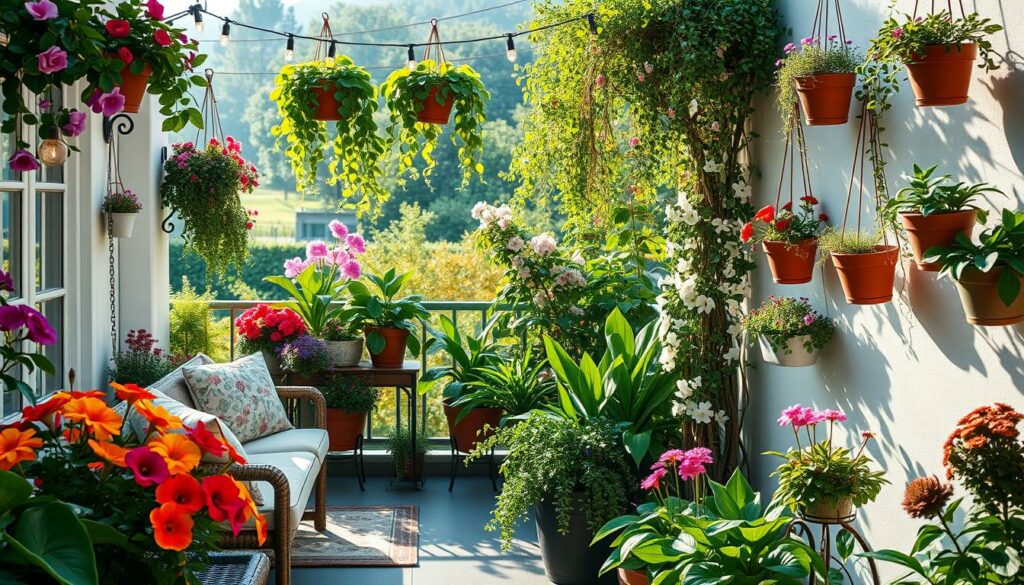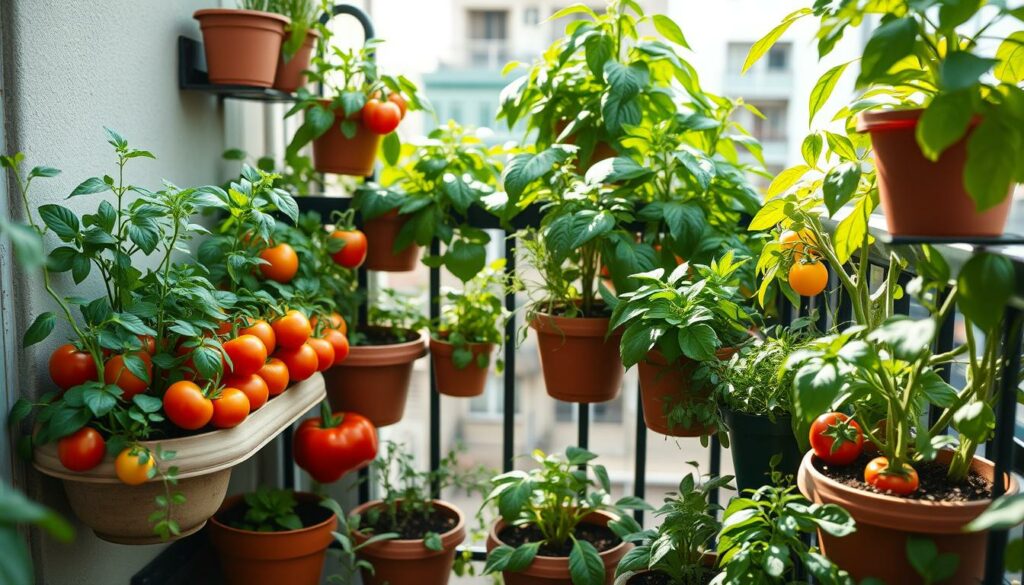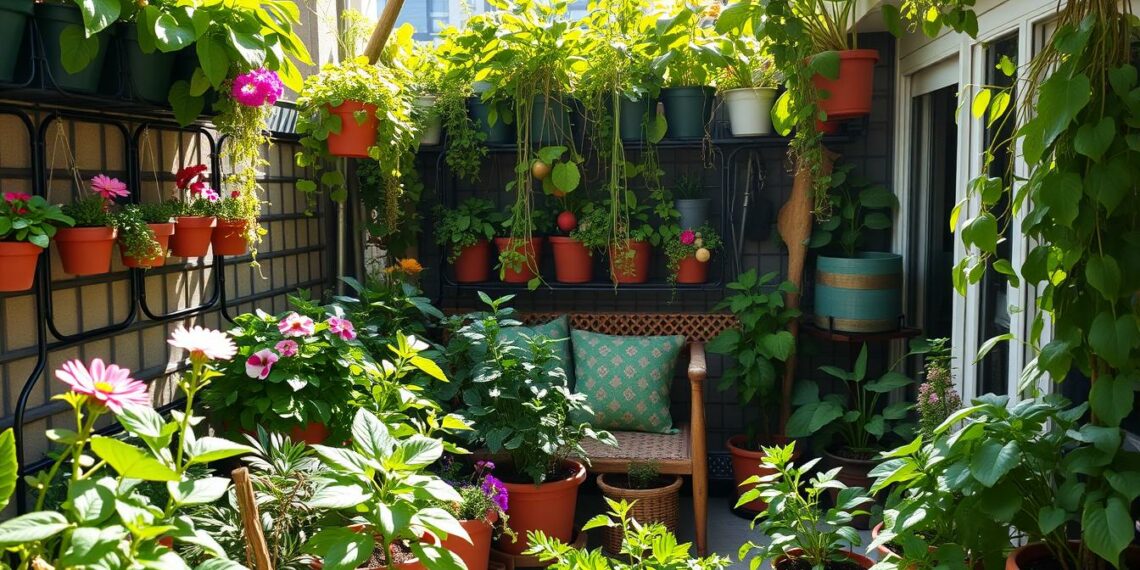Ever thought about growing a garden in a tiny space? With more people living in cities, Small Space Gardening is getting popular. It uses smart techniques to make the most of every inch. This guide will give you key tips for gardening in small areas, from container gardening to balcony gardens. It uses advice from big names like Fine Gardening and Plant Care Today to help you make your small space green and beautiful.
If you love gardening or want to start a YouTube channel about Urban Gardening, you have a big chance to inspire others. We’ll look at new ways to grow plants in small spaces. These ideas will turn your city spot into a lively garden.
Key Takeaways
- Understanding the importance of niche selection for your gardening channel.
- Innovative techniques for maximizing garden space.
- Insights from popular gardening blogs and social media presence.
- Practical tips for container and balcony gardening.
- Successful niche ideas for YouTube gardening channels.
Maximizing Your Small Space with Container Gardening
Container gardening is a great way to grow plants even in small spaces. It lets you bring greenery into your life, no matter the size of your area. By picking the right containers, soil, and plants, you can make your gardening experience better.
Choosing the Right Containers
When picking containers, think about the material, size, and drainage to keep plants healthy. You can use ceramic, plastic, wood, or recycled materials. For example, salvaged pallets can make your garden look unique and be eco-friendly. Containers with good drainage help roots grow and prevent diseases.
Best Soil Types for Container Plants
The soil for containers should be light but absorb moisture well. A mix of good potting soil, coconut coir, or vermiculite works great. This blend helps roots grow strong and lets your plants flourish.
Plants Suited for Container Gardening
Many plants do well in containers, whether you’re a beginner or an expert. Consider growing herbs, small vegetables, and colorful flowers. Plants like Fino Verde basil, Romeo baby carrots, and Red Robin tomatoes are tasty and pretty. Microgreens, like baby spinach and lettuces, grow fast and fit well in containers.
| Container Type | Benefits | Best for |
|---|---|---|
| Ceramic | Elegant appearance, natural insulation | Herbs, Annual Flowers |
| Plastic | Lightweight, versatile | Dwarf Vegetables |
| Wood | Eco-friendly, retains moisture | Rooftop Gardens |
| Recycled Materials | Cost-effective, unique aesthetics | All Container Plants |
The Benefits of Urban Gardening
Urban gardening has many benefits for people, communities, and the planet. As cities get bigger, we need more green spaces. Gardening in the city makes life better by improving air quality and helping nature.
It gives us a break from the city’s hustle and bustle. We get fresh food and live more sustainably.
How Urban Gardening Improves Your Environment
Urban gardening is great for the environment. A lively garden takes in carbon dioxide and puts out oxygen, making the air cleaner. Plants also cool the city down, making summer more comfortable.
People who garden feel better physically and mentally. They feel closer to nature, even in the city.
Community Gardening Initiatives
Community gardens show how successful urban gardening can be. In Detroit, over 1,300 gardens produced almost 400,000 pounds of food in 2014. In Camden, New Jersey, gardeners picked nearly 31,000 pounds of produce in one summer.
These gardens bring people together. They help fight food insecurity and teach about growing food sustainably. They also help build stronger communities and offer learning opportunities.
Exploring Vertical Gardening Techniques
Vertical gardening is a great way to make the most of small spaces, especially in cities. By using wall structures, you can grow plants even if you don’t have much ground space. Picking the right design is key to your success.
Choosing the Right Wall Structures
The type of wall structures you choose is crucial for vertical gardening. Here are some options:
- Trellises: Simple yet effective, allowing climbing plants to thrive.
- Vertical Planters: Designed for smaller spaces, offering a variety of planting options.
- Modular Panels: Often come with built-in irrigation systems, enhancing plant growth.
Before you start, think about the space you have, how much sunlight it gets, and the humidity and temperature. This helps you pick the best wall structures for your garden. Start with simple designs and grow your vertical garden over time.
Ideal Plants for Vertical Gardens
Choose plants for vertical gardens that have shallow roots and do well in tight spaces. Here are some good choices:
| Plant Type | Growth Requirements | Benefits |
|---|---|---|
| Herbs | Requires ample sunlight | Useful in cooking and enhances flavors |
| Ferns | Prefers indirect light | Adds greenery without needing too much sunlight |
| Climbing Vegetables | Needs direct sunlight for optimal growth | Provides fresh produce and aesthetic appeal |
Choosing the right soil is also important for vertical gardens. Pick a soil that drains well to prevent mold and root rot. Be careful when watering, adding water slowly to keep the walls safe. Regular care and maintenance will help your vertical garden last longer.
Creating Your Own Balcony Gardens
Designing a balcony garden lets you bring nature into your home. It makes your space look better and feel calmer. Think about your balcony’s shape, how the sun hits it, and what you like to see. This way, you can make a cozy spot that feels welcoming.
Design Tips for an Attractive Balcony Garden
Here are some tips for a beautiful balcony garden:
- Maximize sunlight exposure: Place your plants where they get lots of natural light. This is key for them to grow well.
- Utilize compact furniture: Pick furniture that doesn’t take up too much room. This keeps your space feeling open and inviting.
- Integrate diverse textures: Mix different materials and colors to make your garden interesting. This keeps it looking good and fun to look at.
- Incorporate vertical elements: Use things like trellises or wall planters. This lets your plants grow up and out, without taking up too much space.
Small Space Plant Choices for Balconies
Choosing the right Plants for Small Spaces keeps your balcony looking great. Here are some top picks:
| Plant Type | Benefits | Growth Requirements |
|---|---|---|
| Trailing Vines (e.g., Ivy) | Adds vertical interest and lush greenery. | Thrives in indirect sunlight; regular watering needed. |
| Compact Shrubs (e.g., Boxwood) | Offers structure and year-round greenery. | Prefers well-drained soil; moderate water needs. |
| Container Vegetables (e.g., Tomatoes) | Provides fresh produce even in limited space. | Requires full sun; consistent watering essential. |

Innovative Ideas for Patio Gardens
Turn your outdoor space into a cozy oasis with creative patio garden designs. A well-thought-out patio garden extends your home, offering a stylish spot for relaxation. With the right touches, even a small patio can become a personal retreat.
Setting Up a Stylish Patio Garden
Begin by making the most of your space. Pocket gardens are great for adding life to overlooked spots. You can go for simple grass planters or complex designs with stone. Think about these key elements:
- Low-maintenance plants like succulents and alpine varieties
- Unique planters and containers to enhance your planting arrangement
- A thoughtfully designed lighting scheme to create ambiance in the evenings
Balance looks and function when placing your plants. This approach makes the space welcoming and stylish, perfect for any purpose.
Incorporating Furniture into Your Patio Garden
Garden Furniture Ideas are key to making your patio both comfy and useful. Using multi-use furniture lets you relax and host guests without taking up too much room. Here are some styles to consider:
- Weather-resistant options like weathered teak, which adds rustic charm
- Space-saving designs like foldable chairs and tables to enhance flexibility
- Cushioned seating to promote comfort for long gatherings outdoors
Adding things like hanging plants or decorations can make your patio your own. The right furniture and accessories improve comfort and look, making your patio stylish.
Indoor Gardens: Bringing Nature Inside
Indoor gardens let you bring a lush environment into your home. They make your living space look better, clean the air, and bring calm. With the right plants, you can easily create a beautiful oasis indoors.
Selecting Indoor-Friendly Plants
Choose hardy plants for your indoor garden. Snake plants, pothos, and peace lilies are great choices. They’re not only pretty but also clean the air from toxins. By picking low-maintenance gardening plants, your garden will grow well with little work.
Creating a Low-Maintenance Indoor Garden
Start a low-maintenance indoor garden with the right plants. Pick ones that are tough and fit well indoors. Growing herbs on your kitchen windowsill connects you with nature and keeps work easy. Stick to a regular watering schedule to keep your garden healthy and easy to care for.
Lighting Options for Indoor Gardens
Good indoor garden lighting is key for your plants. LED grow lights work great; they give the right light for plants and look modern. Use natural light when you can, and creative planters can make your indoor space look better.
Studies show that being around nature improves well-being. This shows how important it is to bring greenery into your home. For more on gardening tips, check out finding the right niche ideas that match your interests and skills.
Herb Gardens: Perfect For Small Spaces
Creating a garden with fresh herbs makes cooking more exciting and your home look better. Herb gardens are great for small spaces because they don’t take up much room but add lots of flavor. Starting a kitchen herb garden is a fun and rewarding project. It’s perfect for those who love cooking with fresh ingredients.
Setting Up a Kitchen Herb Garden
Setting up a kitchen herb garden means picking a sunny spot. This can be on a windowsill or a patio. You can use containers or vertical planters to save space. Here are some steps to follow:
- Choose your containers: Make sure they have drainage holes for healthy roots.
- Select a quality potting mix: A blend that retains moisture while allowing for drainage is ideal.
- Position your herbs for sunlight: Most herbs need at least six hours of direct sunlight.
Popular Herbs for Small Gardens
Many herbs do well in small gardens. Here are some top picks:
| Herb | Uses | Growing Conditions |
|---|---|---|
| Basil | Great for pasta, salads, and pesto. | Requires full sun and regular watering. |
| Thyme | Perfect for seasoning meats and vegetables. | Thrives in well-drained soil and sunny spots. |
| Mint | Fresh mint adds flair to drinks and desserts. | Enjoys partial shade and moist soil. |
Adding to your kitchen herb garden lets you try new flavors and turn your small space into a lively oasis. Enjoy the beauty and ease of herbs for small gardens as you make delicious dishes at home.
Starting a Small Space Vegetable Garden
Starting a small vegetable garden is a great way to live sustainably and enjoy fresh food. Choosing the right plants is key to making the most of your space. Pick plants that grow well in small areas and produce a lot of food.
Choosing the Right Crops for Limited Space
When planning your garden, focus on dwarf varieties and plants that don’t spread out too much. These are great for small gardens. Here are some top picks:
- Cherry tomatoes
- Dwarf cucumbers
- Container-friendly peppers
- Radishes
- Compact lettuce varieties
These plants do well in small spaces and taste great.
Vertical Space Utilization for Vegetables
Vertical gardening is a smart way to use small spaces. Using walls, fences, or trellises lets you grow more food. Choose plants that climb, like:
- Peas
- Green beans
- Cucumbers

There are resources available, like guides on planting strategies, to help you figure out how much to plant. By picking the right plants and using vertical gardening, you can have a productive small garden all season.
Gardening Tips for Small Spaces: Niche Ideas for a Gardening Channel
Creating content for a Niche Gardening Channel focused on small spaces needs creativity and engagement. The right themes and decor can make your channel stand out. This lets viewers connect with your gardening journey and get valuable Small Space Gardening Tips.
Using Themes and Décor to Attract Viewers
Themes can give your gardening content a unique touch. Think about minimalist design or eco-friendly practices. You can use elements such as:
- Sustainable Gardening: Share tips on composting and using native plants.
- DIY Urban Gardens: Show projects where viewers can make their own gardens with recycled materials.
- Zen Gardens: Teach how to create peaceful spaces with minimal décor, using rocks and water.
By making these themes come alive, you can draw in more viewers. You’ll also share practical Gardening Content Ideas that hit home with small space gardeners.
Content Ideas for Small Space Gardening Tutorials
Your tutorials on small space gardening can touch on many topics, from plant choices to design strategies. Here are a few top ideas:
- How to set up a balcony garden using vertical planters.
- Maintaining an indoor garden with low-light plants.
- Simple ways to grow herbs on window sills.
Visual guides and engaging stories will keep your audience hooked. Adding personal experiences and tips makes your channel more relatable. It also makes it a top spot for Small Space Gardening Tips.
Conclusion
Gardening in small spaces is more than a trend; it’s a way to be creative and sustainable. You can grow plants in containers, vertical setups, or indoors. Each method shows how you can make a garden in tight spots, changing your space and improving your life.
This article has shown you how to think differently about gardening. You don’t need a big patio or balcony to garden. With new techniques and plant choices, you can turn your small space into a lively garden.
Starting your small space gardening journey is exciting and rewarding. You now have the knowledge and methods to make a green space that shows your style and improves your city living.
FAQ
What is container gardening, and how can it benefit my small space?
Container gardening lets you grow plants in pots and bins, perfect for small areas. It’s flexible, letting you pick materials and sizes. You can place your garden anywhere with sunlight.
What are the best soil types for container gardening?
The top soil for containers mixes potting soil with things like vermiculite or coconut coir. This ensures your plants get the nutrients and drainage they need to grow well.
How can vertical gardening enhance my urban space?
Vertical gardening uses walls and trellises to increase your planting area. It’s great for small spaces and adds beauty to your area.
What types of plants are suitable for balcony gardens?
For balcony gardens, pick plants like trailing vines, compact shrubs, and container veggies. These plants do well in limited light and space, making your balcony look lush and inviting.
What are the benefits of community gardening?
Community gardens offer fresh produce, bring neighbors together, and improve local ecosystems. They make cities greener and strengthen community ties.
Which indoor plants are ideal for small living spaces?
For indoor gardens, go for tough plants like snake plants or pothos. They’re easy to care for and can grow in different light, improving your air quality and looks.
How do I start a small space vegetable garden?
Start your small vegetable garden with dwarf and compact plants. Use vertical methods like trellises to save space. Choose easy-to-grow crops like cherry tomatoes and peppers for containers.
What are some tips for designing a stylish patio garden?
For a stylish patio garden, mix function with beauty by using furniture that serves more than one purpose. Add colorful planters to show off your style while enjoying your space.
How can I set up a kitchen herb garden in my small space?
Creating a kitchen herb garden is easy. Pick herbs like basil, thyme, and mint that need little space. Grow them in pots on your kitchen windowsill or blend them into your garden.
What content can I create for a niche gardening channel focused on small spaces?
For a gardening channel about small spaces, make content that’s engaging. Share DIY urban garden projects, balcony garden tips, or how to keep indoor plants. This will draw in viewers who want to make the most of their small gardens.




